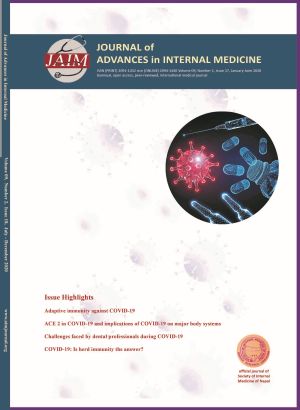Retrospective chart- review of Tetanus cases admitted in a tertiary care hospital
DOI:
https://doi.org/10.3126/jaim.v9i2.32818Keywords:
Infectious disease, tropical neurology, risk factors, outcomeAbstract
Background and Aims: Tetanus is a cause of thousands of death and disability annually in developing countries. Nepal is a low-income country and has achieved maternal-neonatal transmission elimination status. However, the literature regarding the status of generalized tetanus in adult populations is limited. This study was conducted to determine the clinical profile and outcome of patients with generalized tetanus.
Methods: This was a retrospective study conducted among adult patients with generalized tetanus admitted at the Department of Internal Medicine or Department of Anesthesiology and Critical Care at B.P. Koirala Institute of Health Sciences, Dharan, Nepal from January 2012 to December 2016.
Results: Of 40 patients with generalized tetanus, the mean age was 47 } 16 years. Most of the patients were male (95%) and were not vaccinated with tetanus toxoid (67.5%). The most common wound type was skin puncture. Tracheostomy was done in 30 patients (75%). Twenty-nine patients (72.5%) were discharged after completion of treatment, seven patients (17.5%) took leave against medical advice, and three patients (7.5%) died at the hospital during treatment.
Conclusions: Generalized tetanus is still a public health concern in Nepal. It is more common in males and at ages above 40 years. Perforative skin wounds sustained from the wood sticks or needles were a frequent cause. Most of the patients with generalized tetanus needed a tracheostomy and mechanical ventilation. The in-hospital mortality rate of generalized tetanus was 7.5%.
Downloads
Downloads
Published
How to Cite
Issue
Section
License
This license enables reusers to distribute, remix, adapt, and build upon the material in any medium or format, so long as attribution is given to the creator.




